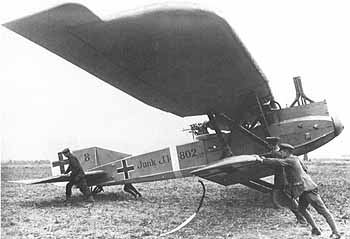- Junkers J.I
infobox Aircraft
name = J.I
type = Observation and ground attack
manufacturer =Junkers 
designer =Otto Mader
first flight = early 1917
introduction =
retired =
number built = 227
status = Retired
unit cost =
variants with their own articles =
primary user = "Luftstreitkräfte "The Junkers J.I (manufacturer's designation J4, not to be confused with the earlier, pioneering
Junkers J 1 all-metal monoplane of 1915/16) was a Germansesquiplane format warplane ofWorld War I , developed for low-level observation and ground attack. It is especially noteworthy as being the first all-metal aircraft to enter mass production. It was a slow aircraft, but its metal construction and heavy armour, which comprised an extremely advanced, single-unit armored "bathtub" that ran from just behind the propeller, to the rear crew position, and acted both as the main fuselage structure and engine mounting setup in one unit, was an effective shield against anti-aircraft defensive fire.Development
pioneering all-metal monoplane prototype began at Dessau and at the beginning of December 1915 the first Junkers aircraft was finished.
The armored "bathtub" concept of the J.I, because Hugo Junkers had to move his aircraft manufacturing equipment out of Germany into the Moscow suburb of Fili in the
Soviet Union during the 1920s, could have been noticed bySergei Ilyushin and remembered by him, when his design bureau worked on the similarly-equippedIlyushin Il-2 "Shturmovik" Soviet ground attack aircraft of World War II. Fact|date=March 2008Operational history
It was well-liked by its crews, although its ponderous performance earned it the nickname "Furniture Van". They were used on the Western Front during the
Kaiserschlacht of March 1918. There were 227 J.Is manufactured during the war.Operators
;flag|German Empire
*"Luftstreitkräfte "urvivors
Only one aircraft survived, bearing German military serial number J.I 586/17 and preserved at the
Canada Aviation Museum inOttawa .Specifications
aerospecs
met or eng?= met
crew=Two, pilot and observer
capacity=
length m=9.1
length ft=29
length in=10
span m=16.00
span ft=52
span in=6
dia m=
dia ft=
dia in=
height m=3.4
height ft=11
height in=2
wing area sqm=49.4
wing area sqft=531
rot area sqm=
rot area sqft=
aspect ratio=
empty weight kg=1,766
empty weight lb=3,893
gross weight kg=2,140
gross weight lb=4,718
eng1 number=1
eng1 type=Benz Bz.IV
eng1 kw= 149
eng1 hp= 200
eng1 kn=
eng1 lbf=
eng1 kn-ab=
eng1 lbf-ab=
eng2 number=
eng2 type=
eng2 kw=
eng2 hp=
eng2 kn=
eng2 lbf=
eng2 kn-ab=
eng2 lbf-ab=
max speed kmh=155
max speed mph=97
max speed mach=
cruise speed kmh=
cruise speed mph=
range km=310
range miles=193
endurance h=
endurance min=
ceiling m=4,000
ceiling ft=13,120
glide ratio=
climb rate ms=
climb rate ftmin=
sink rate ms=
sink rate ftmin=
armament1=2 × fixed, forward-firing 7.92 mmLMG 08/15 machine guns
armament2=1 × trainable, rearward-firing 7.92 mmParabellum MG14 machine gun
armament3=
armament4=
armament5=
armament6=ee also
aircontent
related=
similar aircraft=
*AEG J.I
*AEG J.II
*Albatros J.I
*Albatros J.II
lists=
see also=
*Junkers
*World War I References
*
* "Jane's All the World's Aircraft" 1919, p. 320a-321a
*
* [http://www.aviation.technomuses.ca/collections/artifacts/aircraft/JunkersJ1.shtml Junkers J1 at the Canada Aviation Museum]
Wikimedia Foundation. 2010.
